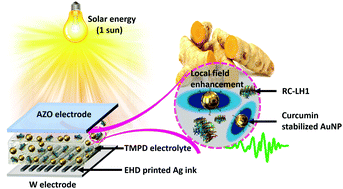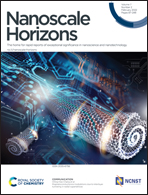Plasmonic protein electricity generator†
Abstract
Interest in acquiring green energy from sunlight is driving research into the incorporation of biological photosynthetic materials into biohybrid devices. A potential way to enhance solar energy conversion by photosynthetic proteins is to couple them to plasmonic nanomaterials to enhance absorption of incident radiation. In this work, a variety of plasmonic nanoparticles were used to boost the photocurrent output of a Protein Electricity Generator (PEG). Mixing gold nanoparticles (NPs) of five different architectures into the photoprotein/electrolyte contents of the cell was found to increase device performance, the most effective being ∼120 nm diameter star-shaped clusters that caused a ∼six-fold increase in photocurrent at the optimum dopant level. In addition, high-resolution electrohydrodynamic printing was used to create parallel line and square lattice patterns of silver nanoparticle ink on the tungsten rear electrode of the cells. Patterns with a 700 nm spacing between lines boosted photocurrents by up to three-fold and the effects of the gold and silver nanoparticles were additive, such that the ideal combination produced a ∼19-fold increase in photocurrent and device efficiency. We attribute the elevated performance to plasmonic enhancement of absorbance and scattering effects that increase the path length for photons in the device. Use of rear electrodes with silver nanoparticle lines and grids at 1100 nm spacing did not increase photocurrents, highlighting the importance of precision printing of nanostructures for the enhancement of device performance.



 Please wait while we load your content...
Please wait while we load your content...